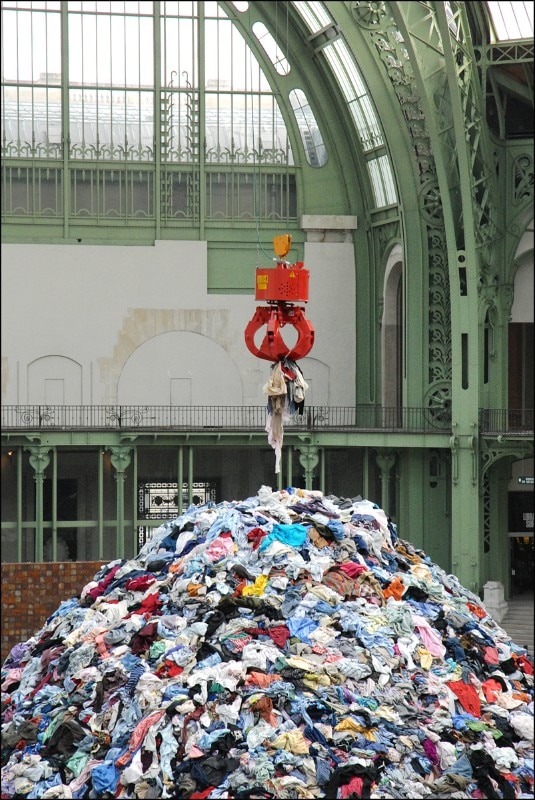Monumental, iconic, autobiographical without necessarily talking about himself: three adjectives that well sum up the personality of Christian Boltanski, perhaps the most renowned contemporary French artist, who passed away last week aged 76.
Born in 1944 during the Nazist occupation of France, the mother (Catholic) sheltered for a year and a half the father (jewish) beneath the floor of the Parisian flat where the family lived. The young Boltanski, a self-taught artist, was no wonder marked by his childhood story, although experienced without full consciousness. For the rest of his life his art would therefore become a tribute to all those disappeared and forgotten people, to innocent victims, to loss, pain and remembrance.

The tragedy of the Shoah and, in general, of death are the background against which many of his installations, crowned with some of the world’s most significant awards and eulogies, developed. Boltanski was awarded the Praemium Imperiale for sculpture in 2006, despite the artist had always considered himself a painter; he represented France at the 2011 Venice Biennale with the installation Chance; and partook to the 1972 and 1978 editions of Documenta, the Kassel quinquennial, the world’s most influential and intellectual event for contemporary art, in addition to hosting an endless string of personal exhibitions in the most important museums of the globe, like the Centre Pompidou in his Paris.
In Italy, in Milan, we had the opportunity to witness a “co-creation” of his not so long ago. In 2018, the environments of the Pirelli HangarBicocca were filled with a series of pieces that the audience could help themselves with: it was “Take Me (I’m Yours)”, a collective exhibition displaying the works of 56 international artists from different generations. Hosted by a plethora of museums across the globe, this participative art project engaged with the concept of offering the audience the possibility of interacting with (serial or replicable) works of art and to make them disappear by taking them home. This concept, nonetheless a silver lining with the poetics of the artist, was born in 1995 out of a conversation between Boltanski himself and Hans-Ulrich Obrist.

Only a few years earlier, the Milan HangarBicocca hosted “Personnes”, a downsized reproduction of the monumental installation the artist made for Monumenta 2010; a project supported by the French Ministry of Culture that, every year since 2007, calls some of the most influential global artists by challenging them to conceive a site-specific installation in the massive environments of the Grand Palais in Paris.
In this site, the visitors of “Personnes” were greeted by a rusty metal wall, only to subsequently face a rectangular floor – where people could walk across – covered in clothes methodically arranged in squares, from which the amplified and mixed sounds of heartbeats were unleashed. Underneath the site’s dome - in the furthest point from the central nave - a huge mechanical arm randomly grabbed clothes from a gigantic pile, letting some to fall on the ground, squeezing others, on repeat.
Discovering and investigating Boltanksi’s exhibitions was never an easy job: his imagery, without indulging in metaphors, was made up of the darkest sides of history...
In the Hangar, though, this project resulted even more powerful, if possible: through a long, one way corridor lit only by a series of neon lights, surrounded by a cage and by the restless amplified heartbeats – that Boltanski had been recording since 2008 for his Archives du Coeurs – the audience reached the Cube, a mountain made of clothes that occupied the whole surface of the site for several metres. Also in this case, a crane randomly lifted its victims, to then throw them down onto the floor. Discovering and investigating Boltanksi’s exhibitions was never an easy job: his imagery, without indulging in metaphors, was made up of the darkest sides of history: the erased identity of deported people, beginning from their undressing, the beats of their frightened and painful souls, the noise of the coinvoils leaving from many European cities to accomplish the “Final Solution”.

His whole portfolio is an apology of pain organised in a sublime way. It is in Italy, in Bologna, that is permanently displayed one of the most brilliant works of the French artist: the installation for the Museo per la Memoria di Ustica. Minimalistic, surprising, touching: 81 lights, the number of the victims of the air disaster, come down from the ceiling, turning on and off to the rhythm of a breath, surrounding the carcass of the DC9 Itavia plane that was shot down on its Bologna-Palermo journey off the shores of the island of Ustica on June 27, 1980.
Around the relics of the plane, also 81 black mirrors: they reflect the audience and whisper statements about the victims told by their family members. Nine big black boxes collect, in no specific order, the personal effects that were supposed to belong to the passengers.
It happens that one’s eyes glisten with tears; it’s far from surprising, it simply is the power of a type of art that – without excessive superstructures – awakens history, and mostly all the pain that although caused by someone unknown somehow backlashes onto us, involuntary witnesses and carriers of a guilt belonging to those who remain.
Opening image: Christian Boltanski by Juan García from Institut Valencià d'Art Modern.

